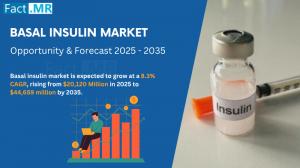Basal Insulin Market is Expected to Reach a Valuation of USD 44,659 Million in 2035 | Fact.MR Report
Basal Insulin Market surges with rising diabetes burden: Long-acting formulations and once-daily dosing drive adherence.
ROCKVILLE, MD, UNITED STATES, July 23, 2025 /EINPresswire.com/ -- According to Fact.MR, a market research and competitive intelligence provider, the basal insulin market was valued at USD 18,893 million in 2024 and is expected to grow at a CAGR of 8.3% during the forecast period of 2025 to 2035.The rising global prevalence of diabetes is causing the basal insulin market to record impressive growth fostered by the trend toward long-acting analogs and less complex treatment plans. urban busy professionals, geriatric patients, and insulin-dependent of type 2 diabetes clog the need of convenient therapies, which require less hypoglycemia to disrupt their worklife. Modern Basal analogues when compared to traditional intermediate basal insulin provide stable 24hours control of glucose, fewer peaks and they are less likely to result in nocturnal hypoglycaemia thus being preferred by both the patient and the physician.
Second-generation basal insulin analogs like insulin glargine (U300) and insulin degludec are transforming diabetes care with their long-acting action, flexible dosing, and better patient compliance. Their once-daily dosing suits modern lifestyles, offering stable pharmacokinetics and fewer meal timing restrictions. Supported by evidence of reduced variability and hypoglycemia, these clean-label injectables—with minimal additives and advanced delivery systems like prefilled pens—are especially appealing for active individuals and those with unique lifestyle needs.
For More Insights into the Market, Request a Sample of this Report: https://www.factmr.com/connectus/sample?flag=S&rep_id=10812
Key Takeaways from Market Study
* The basal insulin market is projected to grow at 3% CAGR and reach USD 44,659 million by 2035
* The market created an absolute $ opportunity of USD 24,539 million between 2025 to 2035
* North America is a prominent region that is estimated to hold a market share of 4% in 2035
* North America is expected to create an absolute $ opportunity of USD 6,599 million
“The emotional relief of reduced injections and the functional value of steady glucose control is reshaping insulin preferences” says a Fact.MR analyst.
Leading Players Driving Innovation in Basal Insulin Market:
Key players in the basal insulin industry include Novo Nordisk, Sanofi, Eli Lilly, Biocon, Wockhardt, Julphar, Sedico, Boehringer Ingelheim, Merck, Pfizer, Sandoz, Viatris, Tonghua Dongbao, and other notable companies.
Market Development
Major players in the industry are becoming even more innovative: Sanofi, Novo Nordisk and Eli Lilly are investing in biosimilar basal insulins to increase affordability of insulin in emerging economies. Driving adoption are developments which are specific to the patient such as app connected smart pens, glucose tracking powered by AI and pharmacist assisted titration tools. Technology breakthroughs, which will improve the pain of injection site and necessitate less freezing requirements are also finding ground. There is developing sustainability activity, with companies investigating recyclable pens and recyclable packaging. Home insulin delivery subscription services and individualized models of care to people with diabetes are reinventing access to home insulin delivery in the developed and underserved areas.
For example, In March 2025, Novo Nordisk launched its next-generation insulin degludec formulation with enhanced stability for tropical markets, targeting expanded access in Southeast Asia and Sub-Saharan Africa.
Buy Report – Instant Access: https://www.factmr.com/checkout/10812
More Valuable Insights on Offer
Fact.MR, in its new offering, presents an unbiased analysis of the basal insulin market, presenting historical data for 2020 to 2024 and forecast statistics for 2025 to 2035.
By Product Type (Insulin Glargine, Insulin Detemir, Insulin Degludec, Biosimilar Basal Insulin, Others [e.g., NPH insulin]), By Diabetes Type (Type 1 Diabetes, Type 2 Diabetes), By Delivery Method (Vial and Syringe, Pen, Pump, Injection Ports), By Distribution Channel (Hospital Pharmacies, Retail Pharmacies, Online Pharmacies, Clinics and Ambulatory Settings), and across major regions of the World (North America, Latin America, Western Europe, Eastern Europe, East Asia, South Asia & Pacific, and Middle East & Africa).
Check out More Related Studies Published by Fact.MR Research:
Expanding at a high-value CAGR of 9%, the global basal cell carcinoma treatment market is expected to increase from a valuation of US$ 6.3 billion in 2023 to US$ 15 billion by the end of 2033.
The global insulin pumps market is expected to reach USD 16,856 million by 2035, up from USD 7,179 million in 2024. During the forecast period (2025 to 2035), the industry is projected to expand at a CAGR of 8.1%.
About Us:
Fact.MR is a distinguished market research company renowned for its comprehensive market reports and invaluable business insights. As a prominent player in business intelligence, we deliver deep analysis, uncovering market trends, growth paths, and competitive landscapes. Renowned for its commitment to accuracy and reliability, we empower businesses with crucial data and strategic recommendations, facilitating informed decision-making and enhancing market positioning. With its unwavering dedication to providing reliable market intelligence, FACT.MR continues to assist companies in navigating dynamic market challenges with confidence and achieving long-term success. With a global presence and a team of experienced analysts, FACT.MR ensures its clients receive actionable insights to capitalize on emerging opportunities and stay ahead in the competitive landscape.
Contact:
US Sales Office:
11140 Rockville Pike
Suite 400
Rockville, MD 20852
United States
Tel: +1 (628) 251-1583
Sales Team : sales@factmr.com
Follow Us: LinkedIn | Twitter | Blog
S. N. Jha
Fact.MR
+1 628-251-1583
sales|factmr.com| |sales|factmr.com
Legal Disclaimer:
EIN Presswire provides this news content "as is" without warranty of any kind. We do not accept any responsibility or liability for the accuracy, content, images, videos, licenses, completeness, legality, or reliability of the information contained in this article. If you have any complaints or copyright issues related to this article, kindly contact the author above.
Anytime Garage Doors Introduces Smart Garage Door Opener Installations in Kansas City Metro Areas
Veteran Consultant and Author Gary Goldstick Shares Bold Insights and Stories in Four Distinctive Books
Geoffrey M. Reid is proud to present his book 'The Revenue Catalyst'
Więcej ważnych informacji
 Jedynka Newserii
Jedynka Newserii

 Jedynka Newserii
Jedynka Newserii

Konsument

Tylko 35 proc. Celów Zrównoważonego Rozwoju ONZ możliwe do osiągnięcia przed 2030 r. Potrzebna ściślejsza współpraca międzynarodowa
Jak wynika z raportu ONZ, choć w ciągu ostatniej dekady dzięki dążeniu do realizacji przyjętych celów udało się poprawić życie milionów ludzi na całym świecie, to jednak tempo zmian pozostaje zbyt wolne, by dało się je osiągnąć do 2030 roku. Postęp hamują przede wszystkim eskalacja konfliktów, zmiana klimatu, rosnące nierówności i niewystarczające finansowanie. Jak wynika ze sprawozdania Parlamentu Europejskiego, problemem jest także brak ścisłej współpracy międzynarodowej i sceptyczne podejście niektórych państw ONZ.
Przemysł spożywczy
UNICEF: Wszystkie dzieci poniżej piątego roku życia w Gazie cierpią z powodu niedożywienia. Sytuacja jest katastrofalna

Ataki Izraela na Strefę Gazy i jej izolacja doprowadziły do całkowitego załamania podstawowych usług i ograniczenia możliwości dostaw i dystrybucji pomocy humanitarnej – wskazuje UNICEF. W efekcie setki tysięcy Palestyńczyków są w sytuacji ciągłego zagrożenia życia i cierpią z powodu niedożywienia i głodu. Ta klęska dotyczy praktycznie wszystkich dzieci poniżej piątego roku życia. Konflikty są jednym z głównych przyczyn braku bezpieczeństwa żywnościowego, głodu i niedożywienia na świecie. Szczególnie dotyczy to Afryki i Azji Zachodniej.
Prawo
Branża ciepłownictwa czeka na unijną i krajową strategię transformacji. Liczy na większe fundusze i korzystne regulacje

Komisja Europejska zapowiedziała rozpoczęcie w I kwartale 2026 roku prac nad strategią dla ciepłownictwa i chłodnictwa. Nad tym strategicznym dokumentem w zakresie ciepłownictwa pracuje także polski rząd. Branża podkreśla, że obie te strategie będą miały kluczowe znaczenie dla trwającej transformacji w ciepłownictwie, czyli przyszłości ogromnych inwestycji, które czekają sektor do 2050 roku. Jednocześnie apeluje o większe wsparcie tego procesu ze środków publicznych.
Partner serwisu
Szkolenia

Akademia Newserii
Akademia Newserii to projekt, w ramach którego najlepsi polscy dziennikarze biznesowi, giełdowi oraz lifestylowi, a także szkoleniowcy z wieloletnim doświadczeniem dzielą się swoją wiedzą nt. pracy z mediami.


![Nestlé w Polsce podsumowuje wpływ na krajową gospodarkę. Firma wygenerowała 0,6 proc. polskiego PKB [DEPESZA]](https://www.newseria.pl/files/1097841585/fabryka-nesquik_1,w_85,r_png,_small.png)






.gif)

 |
| |
| |
|